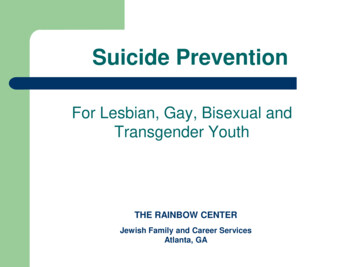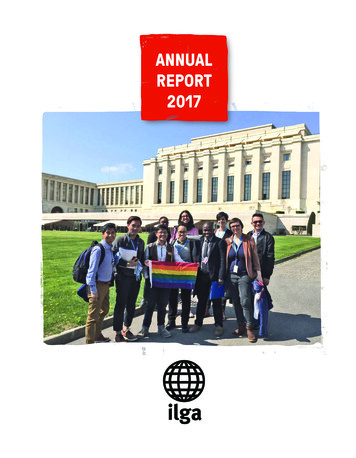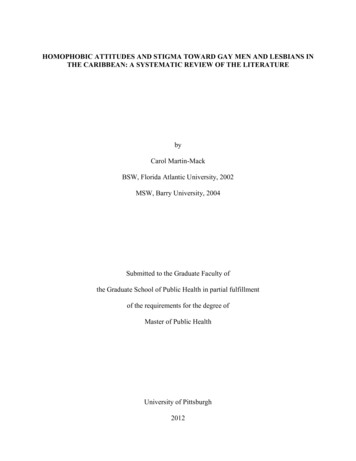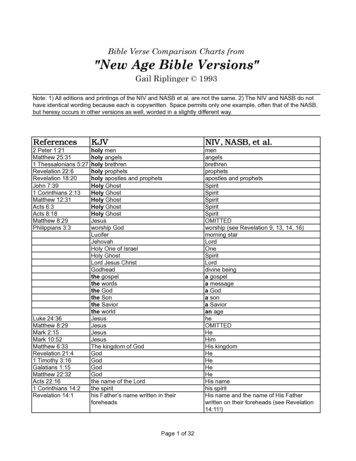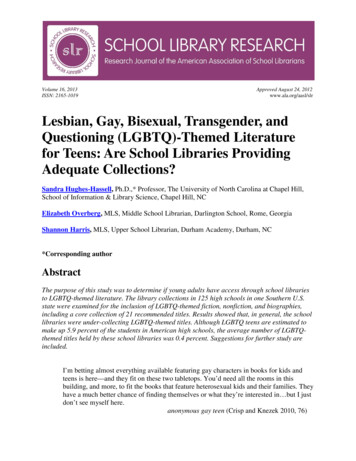
Transcription
Volume 16, 2013ISSN: 2165-1019Approved August 24, 2012www.ala.org/aasl/slrLesbian, Gay, Bisexual, Transgender, andQuestioning (LGBTQ)-Themed Literaturefor Teens: Are School Libraries ProvidingAdequate Collections?Sandra Hughes-Hassell, Ph.D.,* Professor, The University of North Carolina at Chapel Hill,School of Information & Library Science, Chapel Hill, NCElizabeth Overberg, MLS, Middle School Librarian, Darlington School, Rome, GeorgiaShannon Harris, MLS, Upper School Librarian, Durham Academy, Durham, NC*Corresponding authorAbstractThe purpose of this study was to determine if young adults have access through school librariesto LGBTQ-themed literature. The library collections in 125 high schools in one Southern U.S.state were examined for the inclusion of LGBTQ-themed fiction, nonfiction, and biographies,including a core collection of 21 recommended titles. Results showed that, in general, the schoollibraries were under-collecting LGBTQ-themed titles. Although LGBTQ teens are estimated tomake up 5.9 percent of the students in American high schools, the average number of LGBTQthemed titles held by these school libraries was 0.4 percent. Suggestions for further study areincluded.I’m betting almost everything available featuring gay characters in books for kids andteens is here—and they fit on these two tabletops. You’d need all the rooms in thisbuilding, and more, to fit the books that feature heterosexual kids and their families. Theyhave a much better chance of finding themselves or what they’re interested in but I justdon’t see myself here.anonymous gay teen (Crisp and Knezek 2010, 76)
LGBTQ-Themed Literature for TeensVolume 16 ISSN: 2165-1019IntroductionUnder the very best of conditions, navigating adolescence can often be a confusing, lonely, andoccasionally overwhelming experience, as teens seek to find their way between the expectationsothers have for them, both peers and adults, and the drive to lay claim to their newly independentself. Navigating adolescence is a process of exploration and experimentation, of tentativediscovery and evolving self-understanding. Identity formation, the main task of adolescence,requires a relatively safe and supportive framework within which adolescents can come to knowtheir true selves (Hughes-Hassell and Hinckley 2001). For heterosexual adolescents, manyavenues of support exist: family, friends, school, and the community (Sears 1991). Identityformation is a much more difficult task for most lesbian, gay, bisexual, transgender, andquestioning (LGBTQ) youth. These young adults often come of age in communities where fewgay adults are visible, attend schools that have no openly gay staff, and interact with peers whouse “fag” and “dyke” as the favored insult and “that’s so gay” as a common put-down (Kosciw etal. 2012; Sears 1991). In this environment LGBTQ adolescents struggle with the decision of notjust who they are, but whether they are, and who they dare tell about it. Not surprisingly, manyLGBTQ youth fear that candor will bring only rejection, and struggle through adolescencefeeling completely isolated and alone (Ryan and Futterman 1998).Compounding their feelings of isolation are often concerns for their safety. Despite increasingsocietal acceptance of gay rights, the LGBTQ community remains—by far—the minority mosttargeted in hate crimes (Potok 2010). According to the 2011 National School Climate Surveyconducted by the Gay, Lesbian and Straight Education Network (GLSEN), 63.5 percent ofLGBTQ students said they felt unsafe in school because of their sexual orientation. Seventypercent had experienced anti-gay bullying, with 38.3 percent reporting that they had beenphysically harassed (e.g., shoved or pushed) and 18.3 percent reporting being the victim ofphysical assault. LGBTQ students in rural areas and small towns were less safe in school thanstudents in urban and suburban areas (Kosciw et al. 2012).The impact of homophobia and anti-gay bullying on LGBTQ students is not limited to theirfeelings of safety. The same 2011 National School Climate Survey (Kosciw et al. 2012) revealedthat LGBTQ students who were harassed because of their sexual orientation and genderexpression had significantly lower grade-point averages than their peers did (2.9 vs. 3.2).Increased victimization also leads to increased levels of depression and anxiety and to decreasedlevels of self-esteem in LGBTQ students. The isolation and despair LGBTQ youth experienceplaces them at high risk for a variety of other problems including homelessness, substance abuse,and suicide (Ryan and Futterman 1998). One study found that LGBTQ teens were over fourtimes more likely than their peers to attempt suicide (Massachusetts Dept. of Ed. 2009).LGBTQ youth, just like heterosexual teens, must have opportunities for self-affirmation andsocialization if they are to develop into healthy adults (Kosciw et al. 2012). Many local, state,and national organizations provide LGBTQ youth with opportunities to connect with otherLGBTQ youth and to interact with positive gay adult role models, but locating these programs isoften difficult for teens. Many LGBTQ youth are hesitant to ask adults for information aboutLGBTQ organizations, and in many communities, these organizations are nonexistent.So where can young people who identify as LGBTQ turn for support, safe space, confidentialaccess to information, and materials that speak to their lives? School and public libraries.Research by Linda B. Alexander and Sarah D. Miselis shows that the library is “the mostimportant information source” for LGBTQ people (2007, 45). Library resources can provide self2School Library Research www.ala.org/aasl/slr
LGBTQ-Themed Literature for TeensVolume 16 ISSN: 2165-1019affirmation, offer characters with which to identify, and decrease the feeling of alienation (Rauch2010). Additionally, studies show that “when a young lesbian, gay, bisexual, transgender orquestioning (LGBTQ) teen knows there is an affirming teacher, school nurse, clergy member orparent they can trust, they are much more likely to turn to them for help when they are bullied ordepressed” (GLSEN 2010).The mission of the school library is “to ensure that students and staff are effective users of ideasand information” (AASL 2009, 8). This mission can be interpreted narrowly to mean schoollibraries should collect primarily materials that support the classroom curriculum. While theincreased national focus on the Common Core and Race to the Top, combined with budget cuts,may seem to justify this stance, research has shown that the “essence of teens’ everyday lifeinformation seeking is the gathering of information to facilitate their teen-to-adult maturationprocess” (Agosto and Hughes-Hassell 2006a, 1394). In a 2011 report, the National Center forMental Health Promotion and Youth Violence Prevention argues that schools must help youth“recognize and manage their emotions, appreciate the perspectives of others, establish positivegoals, make responsible decisions, and handle interpersonal situations effectively” (2011, 6).Additionally, many school districts have mission statements that promote multiculturalism anddiversity, both in the curriculum and the library (Curwood 2009). Thus, it would seem that tosupport the full range of teens’ information needs, school libraries must expand their collectionsbeyond curricular-related materials to include resources that address teens’ social, emotional,physical, and sexual needs (Agosto and Hughes-Hassell 2006b). In “Access to Resources andServices in the School Library Media Program: An Interpretation of the Library Bill of Rights,”the ALA Council concurs, stating that school library resources should “include materials thatsupport the intellectual growth, personal development, individual interests, and recreationalneeds of students” (ALA 2008). As Elisabeth W. Rauch points out in a recent article in TeacherLibrarian, school “librarians can provide [LGBTQ] materials and even programming with theknowledge that they are doing so out of professional responsibility” (2011, 14).Unfortunately, few school libraries appear to be providing LGBTQ-themed resources. Less thanhalf (44.1 percent) of the 8,584 students surveyed in the 2011 National School Climate surveyreported that they could find information about LGBTQ-related issues in their school library.Students in the South were the least likely to report access to these resources (Kosciw et al.2011).How accurate are student perceptions? How well are school libraries providing resources forLGBTQ teens, especially at this critical transitional time in their identity development? Severalstudies have analyzed public libraries’ holdings of young adult LGBTQ resources (Boon andHoward 2004; Spence 1999; Rothbauer and McKechnie 1999; Stringer-Stanback 2011), yet nonehave focused on school libraries’ holdings (Clyde and Lobban 2001). The majority of schoollibrary-related articles about LGBTQ issues and resources deal with censorship and policy issues(e.g., Schrader 2009; Storts-Brinks 2010), offer lists of recommended resources (e.g., Clyde andLobban 2005; Rauch 2010),or provide strategies for making school libraries safe places forLGBTQ teens (e.g., Cuseo 2012; Manfredi 2009; Rauch 2010; Schrader 2007). To address thisresearch gap, we analyzed the library collections of 125 high schools in one Southern U.S. statefor the inclusion of LGBTQ-themed books (fiction, nonfiction, and biographies). This articlediscusses the issues underlying the research, and presents the methodology and results of ouranalysis. While our study focused on only high schools in one state, the research could easily bereplicated in any other state or region using the same methodology.3School Library Research www.ala.org/aasl/slr
LGBTQ-Themed Literature for TeensVolume 16 ISSN: 2165-1019Literature ReviewRole of Books in the Lives of LGBTQ TeensLGBTQ teens are at risk when they can’t find materials to help them feel included in theircommunity. Resources can provide self-affirmation, offer characters with which to identify, anddecrease the feeling of alienation (Rauch 2011). Citing research by Linda B. Alexander andSarah D. Miselis (2007), and Hillias J. Martin and James R. Murdock (2007), Elisabeth W.Rauch (2010) concluded that LGBTQ-themed literature provides LGBTQ teens with theopportunity to understand what it means to be queer, to learn gay social norms, to vicariouslyexperience the coming out process, to know they are not alone, to connect with others like them,to find positive role models, and, perhaps most importantly, to affirm the fact that they arenormal.Annemarie Vaccaro, Gerri August, and Megan S. Kennedy (2012) have argued that whenLGBTQ youth see themselves reflected positively in literature they feel a sense of belonging andinclusion. Alternatively, feelings of invisibility can occur in the absence of positive LGBTQimages. In addition to a lack of positive LGBTQ characters in literature, a lack of LGBTQthemed books sends a message to youth that it is not okay to be gay, bisexual, transgender, orlesbian. These teens may have access only to literature that reinforces heterosexism andtraditional gender stereotypes, sending additional messages that the teens’ feelings are wrong.“Sometimes books can be the only safe place to learn about LGBT [Q] issues or to find rolemodels” (2012, 19). To illustrate this point, Vaccaro, August, and Kennedy introduced “Laurie,”who struggled with her same-sex feelings and had no one to talk to. She turned to her librarianfor support and read everything the librarian gave her.Having access to books with LGBT [Q] characters and positive LGBT [Q] messages wasinvaluable [emphasis added] to Laurie’s safety and identity development. The storieshelped her learn that she was not alone in her same-sex feelings.These fictionalcharacters helped her persist in a home and school environment where she never fit it. Inbooks, however, she always felt affirmed and safe (2012, 130).Quality LGBTQ-themed literature can have a positive impact on the entire school community,not just teenagers with same-sex orientation. By collecting tales of friendship, companionship,and romance, school librarians can “help to create a more complete portrait of the life of anLGBT [Q] teenager” (Manfredi 2009, 28). Angie Manfredi has argued that familiarity withLGBTQ-themed literature can help all teens understand what it means to have gay friends,family members, classmates, peers, colleagues, and acquaintances. She outlined a process called“advocating and integrating” (2009, 8), in which school librarians do not just add LGBTQthemed titles to the collection, but actively promote them by featuring them on reading lists,including them in displays, booktalking them, recommending them to teachers for inclusion inthe curriculum, and including them in library-sponsored book clubs.Public Libraries’ Holdings of LGBTQ Young Adult BooksA number of studies have looked at public libraries’ holdings of LGBTQ young adult fiction andnonfiction. In 1999 Alex Spence checked a list of ninety-nine young adult novels with LGBTQcontent recommended by Christine Jenkins (1993, 1998) against the holdings of ten U.S. andnine Canadian urban public library systems’ Online Public Access Catalogs (OPACs). The4School Library Research www.ala.org/aasl/slr
LGBTQ-Themed Literature for TeensVolume 16 ISSN: 2165-1019holdings varied across the libraries with some having substantial collections and others havingonly a few of the titles. His findings were supported by Paulette M. Rothbauer and Lynne E. F.McKechnie (1999) who used a random sample of forty titles from the same authoritative sourceto check the holdings of forty large- and medium-sized Canadian public libraries. The findings oftheir study showed that access to gay and lesbian fiction for young adults in Canadian publiclibraries was somewhat limited and inconsistent, even when the size of the library w
al. 2012; Sears 1991). In this environment LGBTQ adolescents struggle with the decision of not just who they are, but whether they are, and who they dare tell about it. Not surprisingly, many LGBTQ youth fear that candor will bring only rejection, and struggle through adolescence feeling completely isolated and alone (Ryan and Futterman 1998). Compounding their feelings of isolation are often .
